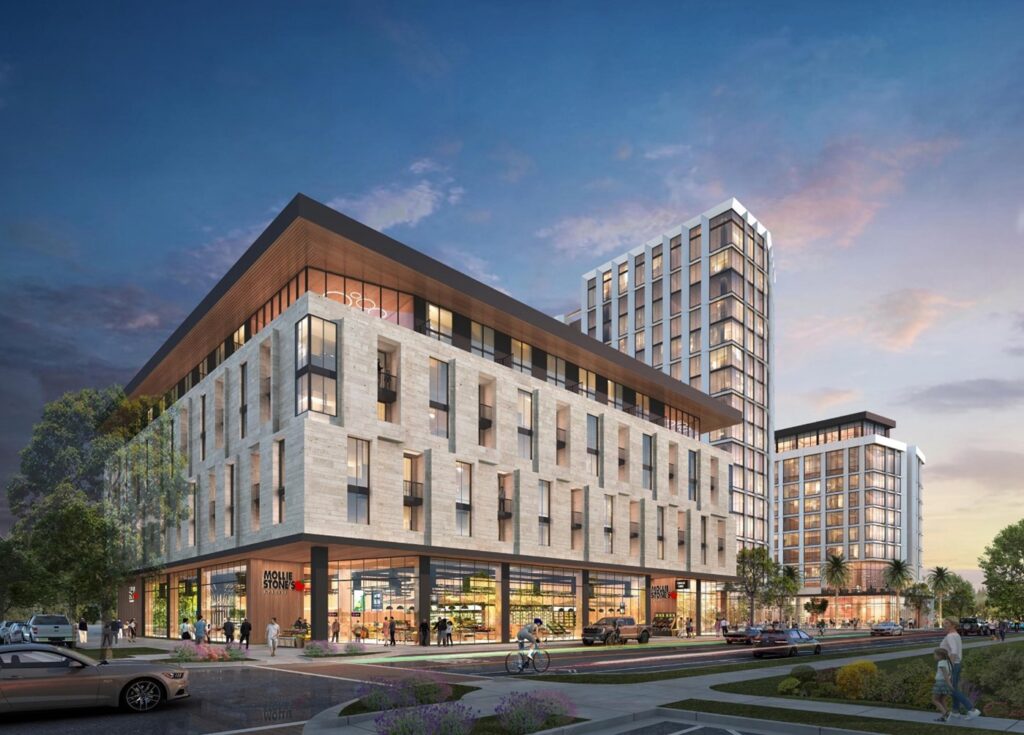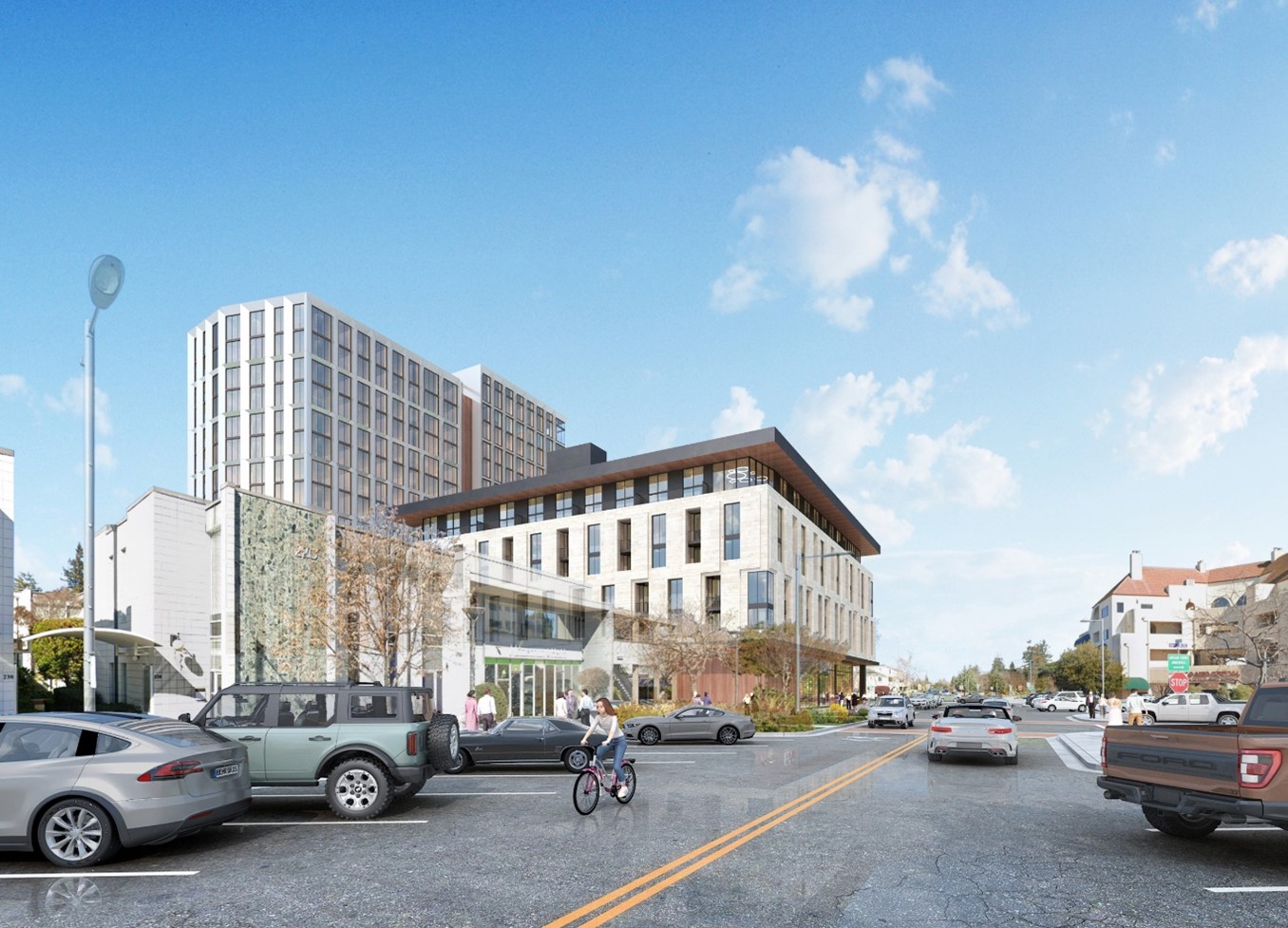Residents, attorneys at odds over whether 382-apartment project represents a problem or a solution
by Gennady Sheyner / Palo Alto Weekly
Uploaded: Thu, Nov 30, 2023, 8:42 am 6
 Redco Development has proposed a three-building development at 156 California Ave. with 382 residential units and one building with a 17-story tower. Rendering by Studio Current/courtesy city of Palo Alto
Redco Development has proposed a three-building development at 156 California Ave. with 382 residential units and one building with a 17-story tower. Rendering by Studio Current/courtesy city of Palo Alto
Depending on whom you ask, the proposed high-rise development near the California Avenue Caltrain station pitched last week is either an exemplar of smart urban planning or an affront to democracy.
Whatever one’s position, the project that Redco Development has proposed, which includes a 17-story tower, has the potential to transform Palo Alto’s low-key “second downtown.” It also adds even more urgency to the city’s already long and frustrating effort to win state approval for its Housing Element.
Redco is hoping to sidestep local zoning restrictions and construct the project with heights and densities never before seen in this part of the city by relying on California’s “builder’s remedy,” a state code provision that applies to cities that do not have a compliant Housing Element.
While the city is arguing that “builder’s remedy” does not apply in Palo Alto because the City Council approved a Housing Element in May, attorneys for the developers are disputing this stance. They point to other cases across California where courts have ruled against cities with non-compliant housing plans, according to a letter obtained by this publication.
The project, which Redco is pursuing in partnership with Midar Investment and with Mollie Stone’s Market, would construct three buildings at 156 California Ave., the current site of Mollie Stone’s.
It includes two residential towers with heights of 177 feet and 123 feet, respectively, as well a seven-story, 77-foot building that will include a new two-story Mollie Stone’s. If built, it would add 382 housing units to the area and stand out as by far the tallest and densest development in the area.
Redco, a San Francisco-based firm, sees the project as exactly what California Avenue needs at a time when many local businesses are struggling and when Palo Alto is facing a state mandate to accommodate 6,086 new homes between now and 2031.
Chris Freise, managing partner at Redco, said in an interview this week that the believes the project’s location — next to a Caltrain station and near a business district — makes it ideal for more housing and a rebuilt supermarket.
“It’s an incredible site next to a Caltrain stop. To do it near transit, it’s like great Urban Design 101,” Freise said. “There’s no better spot than this one.”
He is not alone in feeling this way. Since this publication first reported on the development last week, comments from Palo Alto the community have included the highly enthusiastic (“If ever there was a spot for higher density in Palo Alto, this could be it,” resident Garry Wyndham wrote).
However, other residents, including Palo Alto Mayor Lydia Kou, have come out in opposition (“17 stories? This is a nightmare situation,” resident and former City Council candidate Brian Hamachek posted).
Housing advocates immediately applauded the application. Jordan Grimes, lead member of the housing advocacy group Peninsula for Everyone, called the Redco proposal “joyous news.”
 Redco Development has proposed a three-building development at 156 California Ave. with 382 residential units and one building with a 17-story tower. Rendering by Studio Current/courtesy city of Palo Alto
Redco Development has proposed a three-building development at 156 California Ave. with 382 residential units and one building with a 17-story tower. Rendering by Studio Current/courtesy city of Palo Alto
Grimes said in an interview that he believes that new housing next to a transit station that is about to see greater train frequency thanks to Caltrain’s electrification is needed in Palo Alto and throughout the Peninsula.
The project would be located in a business district that already has shops and other amenities, he noted. And it’s in a city that has experienced tremendous job growth in recent decades but added relatively little housing, he said.
Palo Alto, he added, wouldn’t be subject to a builder’s remedy application if it had followed state law and approved a compliant Housing Element.
“It’s not a paper exercise anymore,” Grimes said. “There are no more rubber stamps. The housing shortage is a dire issue and solving it will require a real process wherein the cities have to analyze the need in their communities and eliminate these barriers to ensure that enough new housing is getting built.
“And the state is holding them to it.”
Redco’s Freise observed that the project site is located just two blocks from 350 Sherman Ave., a former parking lot where the city recently constructed a four-story parking garage. The amount of land that was required to build that garage, Freise said, is roughly equivalent to what the Redco project would occupy.
“Here, we’re keeping the grocery store, keeping parking and building housing. It’s a different approach to land use. Our viewpoint is that this is a more thoughtful way to approach it,” Freise said.
The project will result in a new Mollie Stone’s supermarket occupying the two bottom floors of the seven-story building, according to plans. Mike Stone, CEO of Mollie Stone’s, said in a statement that he supports the application.
“Palo Alto has been a great home for Mollie Stone’s Market since 1990, and the proposed project will ensure it will continue to be for generations to come,” stated Stone, who was among the business owners who had opposed the council’s recent decision to permanently keep a stretch of California Avenue closed to cars, citing the decline in business over the past three years.
“The new state of the art store will be oriented to face California Ave and embrace the pedestrian customer experience to align with the City’s recent action to permanently close California Avenue.”
Destroying cities?
Mayor Lydia Kou, however, sees the project in starkly different terms. In an interview, she criticized both the project and the state laws that have enabled it. One problem, she said, is that the Redco plan does not provide enough affordable housing.
“If the state is going to give away so many benefits and help developers develop, they should at least put in there something that makes sure we address the affordability factor,” Kou said. “Twenty percent is not sufficient. It’s completely egregious. If the state is going to give away so much to developers, it should at least insist that 50% to 55% be truly affordable.”
Her broader concern, however, has to do with the process. By relying on the builder’s remedy provision, the developer is effectively circumventing community involvement in the project and undermining democracy, Kou said.
“I really believe that this is so undemocratic. It’s a completely undemocratic way of destroying cities and keeping people from speaking up,” Kou said.
Whether or not Redco can override local zoning rules and advance its builder’s remedy proposal is a topic of legal dispute. Palo Alto’s city attorneys maintain that builder’s remedy does not apply because the council approved its new Housing Element in May. A statement from the city accompanying its project description notes that the city believes its Housing Element is “compliant with the basic requirements of state law.”
“Notwithstanding this dispute, the City is committed to achieving HCD (California Department of Housing and Community Development) certification and is working diligently toward that goal,” the city’s statement reads.
Attorneys representing the developers strongly dispute this position. In a letter obtained by this publication, they note that the Department of Housing and Community Development has already rejected Palo Alto’s most recent Housing Element draft. They also noted that the city is still in the process of making significant revisions to the document, changes that undermine its status as an “adopted” document.
Pending changes include revising zoning standards on a portion of El Camino Real to enable more residential density and updating the document’s “site inventory” to include additional properties that could accommodate housing.
“Alterations to the City’s Sites Inventory are a significant, substantive change, and the City’s plan to submit a further revised version of the Housing Element to HCD effectively acknowledges that the version adopted on May 8th is not in substantial compliance with Housing Element Law,” attorneys Daniel Golub and Genna Yarkin from the firm Holland & Knight LLP wrote to the city in a letter accompanying the developers’ application.
They also cited recent court decisions, including a July ruling in the case Californians for Homeownership, Inc. v. City of La Cañada Flintridge, in which the courts found the city to be non-compliant with state law despite its “self-certification” of a Housing Element that had not been approved by the state.
“Emerging case law is continuing the trend of the Legislature in finding that housing laws should be interpreted liberally in favor of the production of housing,” Golub and Yarkin wrote. “New cases have specifically reinforced deference to HCD in most instances.”
Kou, for her part, expressed frustration with the state’s approval process and accused the agency of constantly forming new rules and creating new obstacles for cities. The city should continue to challenge developments that fail to comply with local laws, she argued.
“You set up rules and you set up guidelines ahead of time, not as you go along,” she said.


The proposed project is an abomination, It is far too big for the neighborhood.
The real aim of those who want more and higher buildings appears to be destruction of the character of the affected neighborhoods.